by Heather R. Darsie
One of the most iconic images of Elizabeth I in full array as Gloriana, the Virgin Empress of the Seas, is the Rainbow Portrait, painted around 1600. Elizabeth turned 67 years old in 1600. She became Queen of England in 1558, and the weight of her responsibilities was surely showing on her face by this point. Elizabeth was a master of propaganda, and the need to show a vibrant, eternal monarch grew increasingly important through the 1590s and into the early 1600s, before her death in 1603. In this portrait, Elizabeth is elaborately dressed and standing in front of a dark archway supported by columns.
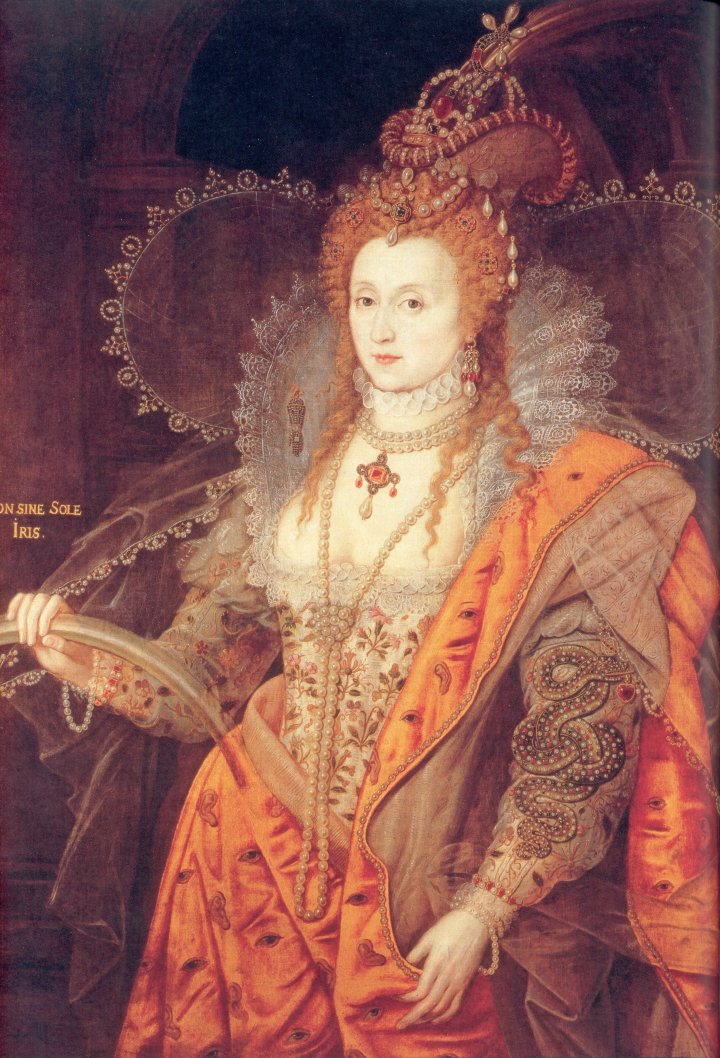
The Rainbow Portrait, c. 1600, attributed to Marcus Gheeraerts the Younger or Isaac Oliver, via Wikimedia Commons.
In the portrait, Elizabeth wears a magnificent gown loaded with symbolism. The lining of her mantle bears eyes and ears, possibly showing her knowledge as omniscient within her realm. Another way of wording it is that the eyes and ears are symbolic of Elizabeth’s impressive spy network.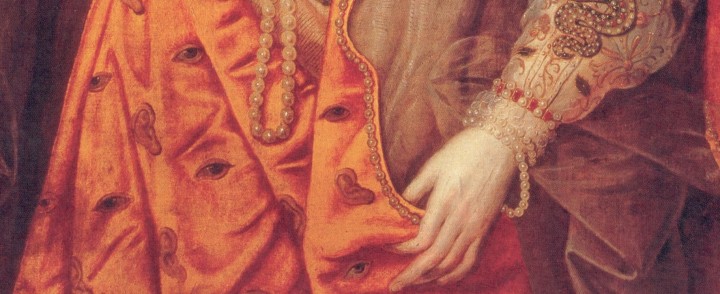
Eyes and ears
Upon the sleeve of that mantle, there is a heavily jeweled snake covered in rubies or another red stone, diamonds, and pearls. The pearls are painted with a dab of bright white paint to show that they are three-dimensional.
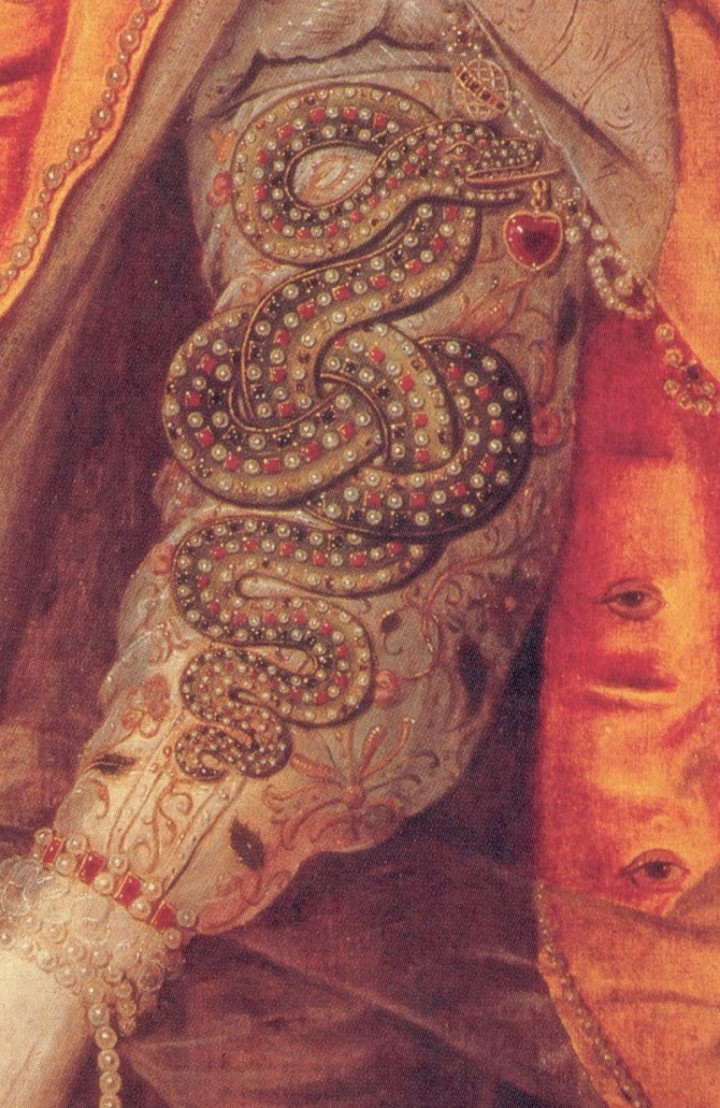
Jeweled Snake
The snake, a cunning creature, holds a heart-shaped ruby in its mouth. Upon its head, there appears to be an armillary sphere, which was a symbol used by both Elizabeth and her mother, Anne Boleyn.
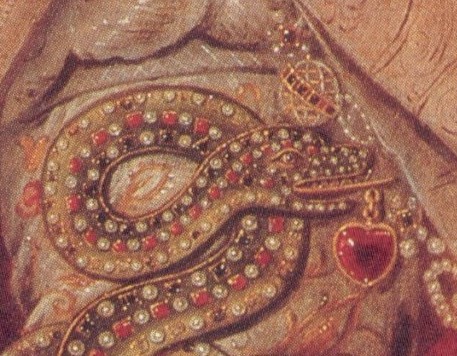
Snake’s head holding heart-shaped ruby with possible armillary sphere on its head
Upon the bodice of her ensemble are various embroidered flowers. Flowers in general are often laden with meaning. In portraiture of the period, young women were depicted holding flowers to show that they were available for marriage, were engaged, and so on. It depended upon which type of flower the young woman was holding. Flowers could also symbolize fertility or growth. Elizabeth had no other children than those of her citizens, but her country experienced rapid growth during her reign. Finally, flowers could symbolize youth. In this portrait, the aged Elizabeth is displayed as eternally youthful. It has been put forth that there is a more subtle meaning to the flowers, and that they are all referenced in Shakespeare’s A Midsummer Night’s Dream.
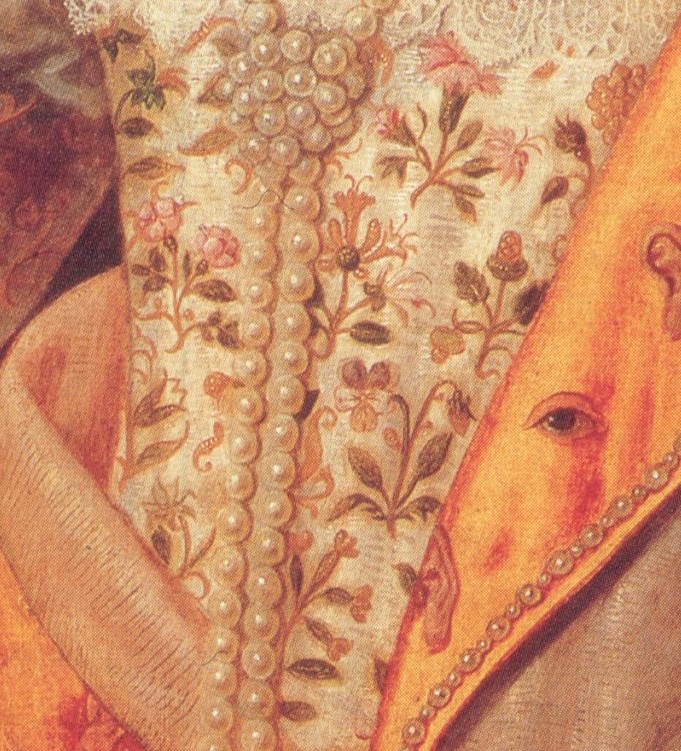
Bodice with Flowers
Perhaps the most fascinating aspect of the bodice and gown is that it possibly still exists. Now known as the Bacton altar cloth, this piece of Elizabethan textile was rediscovered around 2016. Rumours swirled for centuries that the altar cloth, held by St. Faith’s in Bacton, Herefordshire, was donated by Elizabeth’s Chief Gentlewoman, Blanche Parry. The cloth is now safely in the hands of Historic Royal Palaces, undergoing conservation efforts. A closer look at the fabric shows that in addition to flowers, there are deer, bears, butterflies, birds, a man rowing another in a boat, and other fascinating iconography. Below are images of the embroidery, which I found on fiction author Christina Courtenay’s website. However, the fauna depicted on the Bacton altar cloth is noticeably missing from the Rainbow Portrait, so it may have only inspired the bodice design.
Bear, Boatman, Butterfly, and Deer Embroidery on the Bacton Altar Cloth
Elizabeth’s face in the portrait shows not a sign of her age. Indeed, it is a mask of youth, further elevating her as an eternal figure through her political persona as Gloriana. On her head Elizabeth wears what looks like an imperial crown atop her hat. Dangling from the crown is a moon, symbolising virginity and chastity. The moon was also a symbol of Diana, Roman goddess of the hunt. Pearls that drip from Elizabeth’s clothing and jewels are a symbol of her virginity.
Elizabeth’s Face, and the Imperial Crown with Moon
Curiously, there is also a gauntlet in the lace to the right (viewer’s left) of Elizabeth’s face. I would like to suggest that the gauntlet represents the might of her military endeavours. Elizabeth’s navy famously beat the mighty Spanish Armada in 1588, and by the turn of the 17th century, the English were gaining a place in the New World. Additionally, individuals such as Sir Francis Drake successfully harried Spanish and other ships.
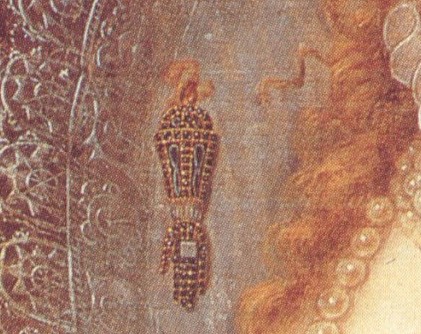
Gauntlet
Lastly, in Elizabeth’s right hand, she holds a rainbow. The rainbow is a symbol of peace. The inscription on the portrait says, “non sine sole iris,” or “Without the sun, there can be no rainbow.” In this radiant portrait of Elizabeth, she is the sun. In other words, the portrait is saying that without Elizabeth, there is no peace.
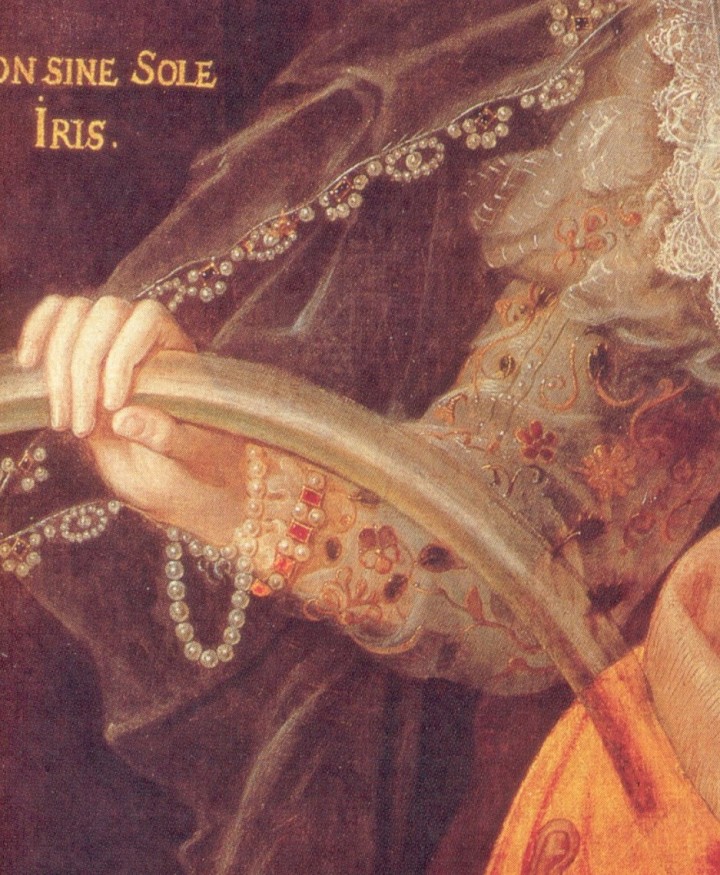
Rainbow and Inscription
Iconography was an important part of politics and propaganda in Elizabethan England, of which the Rainbow portrait is a prime example. Even through someone not trained as an art historian, the powerful messages this portrait displays are easy to understand. There are other significant symbols within this portrait, such as the gauntlet, which require analysis by a trained art historian. To reiterate, the overall the message is clear: without Gloriana, there is no peace in England.
I was inspired to write about the Rainbow Portrait as a nod to those who are within or allies to the LGBTQ community.
For a video about the Bacton altar cloth, please click here.
Love learning about the Queens of England? Are you interested in Tudor history or Women’s history? Then check out my book, Anna, Duchess of Cleves: The King’s ‘Beloved Sister’, a new biography about Anne of Cleves told from the German perspective!
Please check out my new podcast, Tudor Speeches
You Might Also Like
- Gloriana and the Green Ruby
- Sorrow in the City: Reactions to the End of an Age
- Happy 504th Birthday, Anna of Cleves!
- Tudor Speeches: My New Podcast!
- The Curious Case of a Misidentified Portrait of Anne Boleyn
Sources and Suggested Reading
- Ives, Eric. The Life and Death of Anne Boleyn. Oxford: Blackwell Publishing (2004, 2005).
- Felch, Susan M. and Donald Stump, eds. Elizabeth I and Her Age. London: W. W. Norton & Company (2009).
- Dixon, Andrew Graham. ” ITP 91: Elizabeth I: The Rainbow Portrait attributed to Isaac Oliver.” https://www.andrewgrahamdixon.com/archive/itp-91-elizabeth-i-the-rainbow-portrait-attributed-to-isaac-oliver.html Published 13 January 2002. Accessed 6 July 2019.
-
ITP 91: Elizabeth I: The Rainbow Portrait attributed to Isaac Oliver

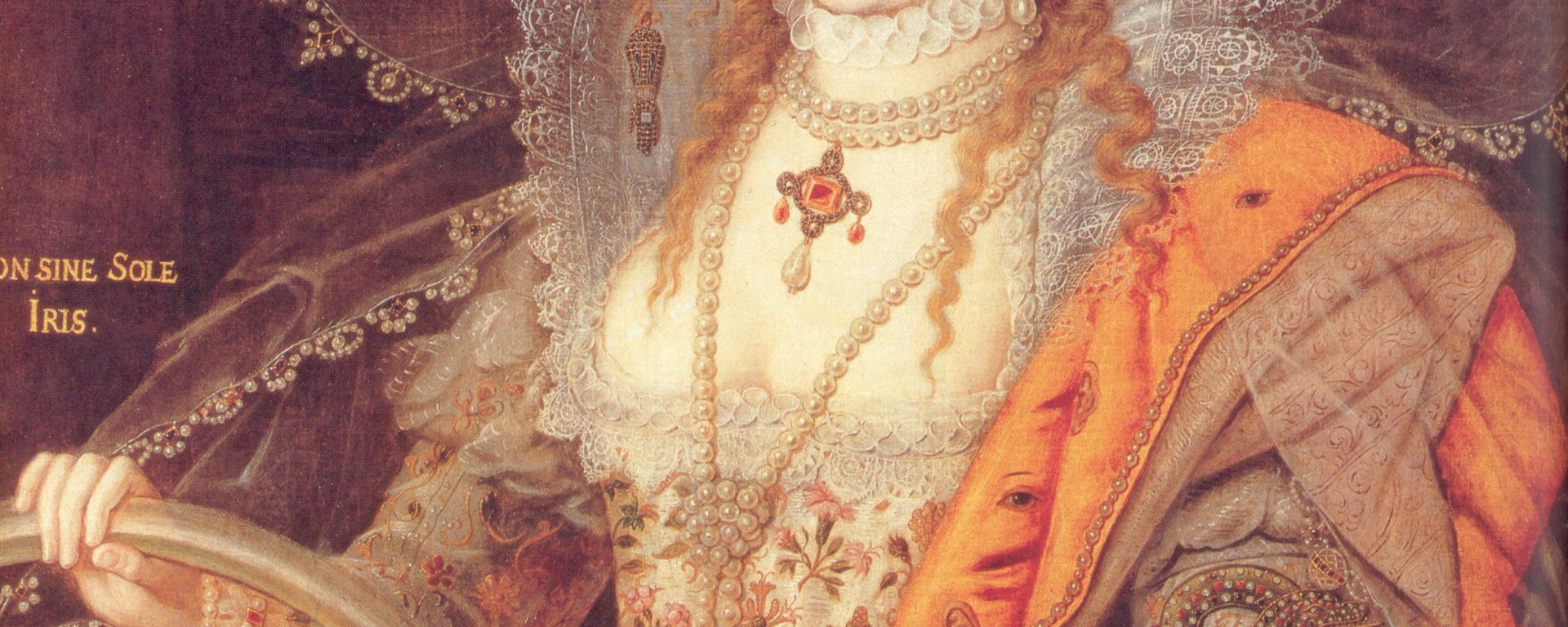






Missing here are the Hermetic/Qabalistic interpretations popular in the day, esp the Rainbow’s representation. Its colors are the Sephiroth from the Tree of Life, which the Shekinah displays. Like the Shekinah, Eliz is the channel for mankind to the divine.
LikeLike
Thank you for adding that!
LikeLike
I’ve always found the array of eyes and ears on Elizabeth’s mantle distinctly unsettling. While they might indicate her omniscience, historian Susan Doran suggests, in “Elizabeth I & Her Circle” (2015) they represent the watchfulness of her servants, particularly Sir Robert Cecil, who probably commissioned the portrait.
It’s ironic that the portrait was painted about the same time as the anxieties around Elizabeth’s failure to nominate a successor and the associated power struggles within her court turned lethal.
LikeLike
Interesting readd
LikeLike